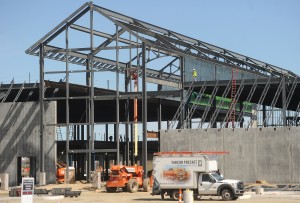BY KEILA TORRES OCASIO
Hearst Connecticut Media
When Bridgeport Jai Alai opened in 1976, East Side business owners were told it would be a boon for their establishments. In reality, visitors rarely strayed from the facility to check out the local haunts, according to Eduardo Reyes, owner of El Coquito, an East Main Street eatery that sells Latino food and tropical ice.
“The only way it affected us was the (increased) traffic,” he said. “And then attendance dropped, it dwindled out and it was gone.”
That’s why Reyes doesn’t want to get his hopes up about the chances of the activity at the massive Steel Point development spilling over into the area.

- Eduardo Reyes, owner of El Coquito on Bridgeport”™s East Side, said he does not think the Steel Point development will increase his business greatly. Photo by Brian A. Pounds
The 52-acre peninsula is just two blocks away from Reyes’ eatery. A Bass Pro Shops, Chipotle and Starbucks are under construction and slated to open there later this year.
Once completely built, the project is expected to have approximately 800,000 square feet of retail, 200,000 square feet of commercial/office, 300,000 square feet of hotel/meeting area, a new 250-slip marina and up to 1,500 residential units.
“The people that go there to buy are not going to come here to eat,” Reyes said.
Making connections
The concern that Steel Point will become an isolated tourist area is one that many elected officials in the area share. Some compare it to Stamford’s Harbor Point project and the way that development has fit into the South End and established connections with the downtown through a trolley system.
“We have to be very mindful and very vigilant that we’re part of the process,” said state Rep. Christopher Rosario (D-128).
He noted that large developments don’t always translate into positive changes for the areas they are built in. “We don’t want to make the same mistakes as other cities, like Atlantic City,” he said. Development there “didn’t really weave into the neighborhood.”
The East Side, separated from Steel Point by Interstate 95, has a gritty public image stemming from a past punctuated by violence, drug use and gang activity. Although much improved, there is still more crime in the neighborhood than other parts of the city.
But Aidee Nieves, president of the East Side Neighborhood Revitalization Zone, said she is confident the improvements made to date will continue to make the neighborhood a more inviting place.
“The fact that an anchor tenant, such as Bass Pro, has chosen to be part of this community should attest to the already diminishing crime rate that local law enforcement, businesses, community leaders and property owners have worked so diligently to achieve,” Nieves said.
An established business district
The East Side has plenty of daily foot traffic on East Main Street, which runs through its center, and a busy business district with small businesses and popular Hispanic eateries.
Alta Gracia Hilario, who manages La Sabrosura Deli & Grocery on East Main Street, said a project as large as Steelpointe Harbor must certainly attract enough visitors to benefit nearby businesses. This year, Bass Pro Shops will host more than 120 million people at its 90 stores and marine centers across the U.S. and Canada, according to its website.
The project is sure to raise property values and has already led to a noticeable increased police presence in the area, Hilario said.
The development will also bring much-needed jobs to the community, said Councilwoman Lydia Martinez (D-137). She said it is up to elected officials to ensure that those jobs go to local residents.
Even El Coquito’s Reyes conceded that workers employed at Bass Pro Shops and other announced tenants may make the short walk to local establishments for meals.
It’s the city’s responsibility to ensure that different options are offered at Steel Point that don’t compete directly with businesses on the East Side, Martinez said.
Results of transformation
While business owners don’t agree on the development’s potential impact, some projects in other parts of state have proven to be transformative for the communities in which they are.
The closest example is the massive $3.5 billion Harbor Point project in Stamford’s South End.
There, Building and Land Technology has built more than 1,000 apartments, a boardwalk, marina and 1 million square feet of retail and office space. A total of roughly 4,000 housing units are planned.
“It’s revolutionized Stamford,” said Thomas Madden, the city’s economic development chief. “It’s changing the dynamics of the city.”
The possibility of transformation in Bridgeport’s East Side, however, raises concerns about gentrification within the community. “One of my concerns is maintaining affordability,” Nieves said. “That is something that can affect residents and small businesses when communities begin changing and developing.”
But Joseph McGee, a vice president of public policy for The Business Council of Fairfield County in Stamford, said the two projects are distinctly different and the East Side already has an established residential neighborhood and business district.
“The fear that if you develop Steel Point all the people on the East Side will be forced out ”“ that’s not going to happen,” he said. “I think what’s going to happen is you’ll see a fixing up of the East Side. The East Side is going to prosper.”
McGee said he foresees neighborhood-based development continuing in the area. “I think Bridgeport has a real chance to pull that off,” he said.
David Kooris, Bridgeport’s economic development director, said Harbor Point’s relationship with the downtown, not the South End, will likely most resemble Steel Point’s relationship with the East Side, as in both cases the neighborhoods are divided by the highway.
“I think there are similarities and there are differences,” he said. “A big difference is the land-use composition. Harbor Point is primarily residential. In Bridgeport, Steel Point is really about economic development. It’s about retail and other developments designed to bring jobs and visitors.”
Both projects, though, focus on providing access to waterfront land that for decades has been denied to the public.
Marketing the area
Kooris said marketing the East Side’s assets, physical improvements to the area and planned developments will be key to getting the economic benefits to move up East Main Street.
“I’d say we’re working on all fronts,” he said.
The city has partnered with the Neighborhood Revitalization Zone to create a brochure mapping neighborhood businesses that can be distributed to visitors entering the city.
They’ve also been working on repaving roads like Waterview Avenue, beginning near the corner of where Bass Pro Shops is being built.
The recent sale of a former boat repair shop on that avenue led to a bidding war for the property. “I think that’s a strong indicator that life doesn’t end after Steel Point, but there’s a whole other area of opportunity,” Kooris said.
He said the city’s efforts to support mixed-use developments planned for the neighborhood and to build a train station in the area will help make it more attractive to outsiders as well.
Kooris said businesses will also have to take a proactive approach to market themselves, ensuring that they have a presence on sites like Yelp and Urbanspoon.
“That to me is the lowest hanging fruit,” he said. “You’re going to have people who are coming to the city for the first time to Steel Point and they’re going to be looking for an authentic eating experience. In many ways that’s going to be a way people will learn about those establishments.”
Ultimately, the city hopes to connect Steel Point to other neighborhoods as well, like the downtown and East End. But because the development is on the East Side, that neighborhood is better positioned to see benefits. “The established East Side and their business district position them best to take advantage of the volume of people,” Kooris said.
Rosario said that the Steel Point developer, Miami-based Bridgeport Landing Development, has experience doing projects of this kind.
“They’ve done a good job weaving their (other) developments into the communities,” Rosario said. “I’m sure they will do the same thing here. And if they don’t we need to make sure our voices are heard.”
Hearst Connecticut Media includes four daily newspapers: Connecticut Post, Greenwich Time, The Advocate (Stamford) and The News Times (Danbury). See ctpost.com for more from this reporter.




















